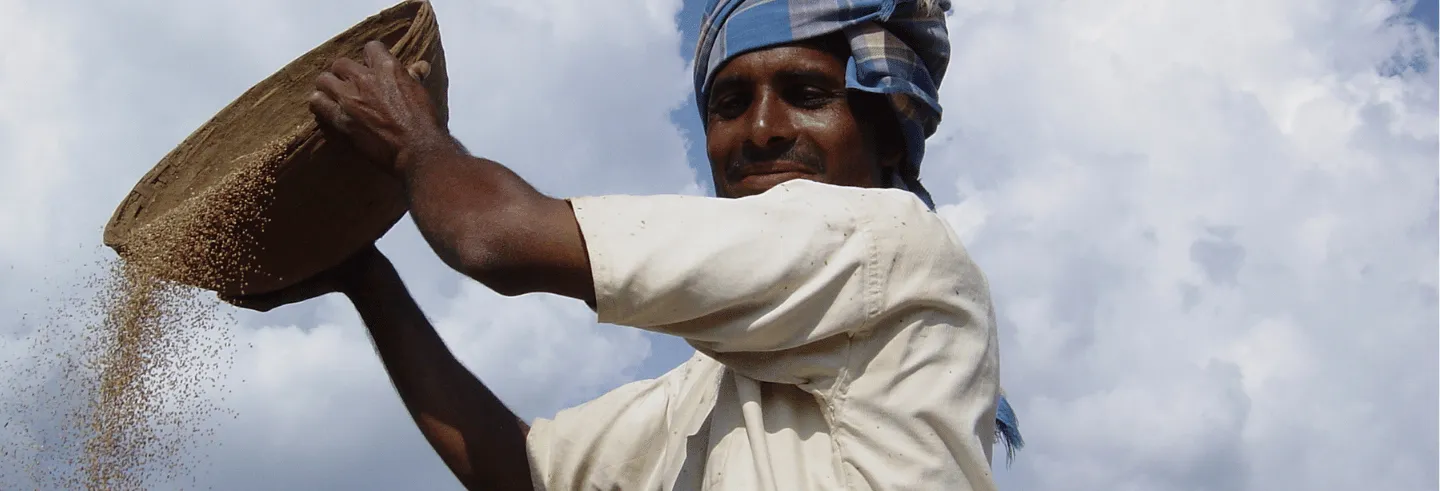In 2024-25, the government procured 42.2% of the rice and 23.1% of the wheat produced in India. Most of this food grain was distributed to more than 800 million people through the public distribution system (PDS). While public procurement of food grains plays a crucial role in ensuring food security for millions of Indians, it has incentivised the production of rice and wheat at the expense of alternative crops, such as millets, pulses, and oilseeds, which have lower water and carbon footprints (Davis et al. 2018; Chakraborti et al. 2023). The negative environmental impact of the PDS is further exacerbated by the concentration of rice and wheat procurement in states with high water stress such as Punjab and Haryana (Bhattarai et al. 2021; Chatterjee et al. 2024).
…[I]n the case of rice, applying true cost accounting involves identifying all costs associated with its production, distribution, and consumption.
In this article, we share the findings from a study by us that uses true cost accounting (TCA) to estimate the “true cost” of producing and distributing rice, wheat, and major millets (bajra, jowar, and ragi) through the PDS (2024). We find that the true cost of producing and distributing rice and wheat through the PDS is 2 and 1.8 times that of major millets. We discuss two ways to make the PDS more sustainable—first, replacing part of the current rice and wheat allocation with millets; and second, further expanding rice and wheat procurement to buy more food grain from states such as Bihar and Uttar Pradesh. These states are home to approximately 30% of PDS beneficiaries and produce more than 26% of rice and wheat, but account for less than 10% of rice and wheat procurement.
True Cost Accounting
There is an increasing recognition that the price we pay for our food does not reflect its true cost (FAO 2023; Rockefeller Foundation 2021). For example, when we buy a kilogram of rice in the market, its price covers the costs of production (such as inputs and labour) and distribution (such as storage and transportation). However, it does not account for production-related costs such as those associated with global warming resulting from greenhouse gas (GHG) emissions, water scarcity, or health issues related to the burning of crop residue.
True cost accounting (TCA) is a type of cost-benefit analysis that focuses specifically on the food system. It aims to address this gap in the “financial” and “true” costs of food by identifying, quantifying, and monetising the environmental, health, economic, and livelihood impacts associated with food.
For example, in the case of rice, applying TCA involves identifying all costs associated with its production, distribution, and consumption. These costs, or metrics, are then quantified and monetised to estimate the true cost of rice. Some examples of TCA applications include estimates of the true cost of food at the global level by the United Nations (FAO 2023), the true cost of food in the United States (Rockefeller Foundation 2021), and the true cost of sustainable rice production in Thailand (Khon Kaen University 2022).
We use TCA to estimate the true cost of the PDS. The PDS is vital for ensuring food security for millions of Indians. However, its reliance on rice and wheat primarily from a few states in north-western India has led to several environmental and health problems. Yet, these negative impacts are not included in the “financial” cost of providing rice and wheat through the PDS. Quantifying some of these hidden costs can help identify ways to reduce the true cost of the PDS.
PDS Rice, Wheat, and Millets
We estimate the true cost of producing and distributing rice, wheat, and major millets (bajra, jowar, and ragi) through the PDS. While there are many hidden costs associated with the production and distribution of these food grains, we focus on four costs—the use of scarce water, greenhouse gas emissions, fertiliser subsidies, and power subsidies. These metrics have been chosen because they have a significant impact and reliable data is available for them. As we only include these four metrics, our true cost estimates are conservative.
The largest hidden costs are due to using scarce water, particularly in Punjab and Haryana. There is a high dependence on irrigation for producing wheat.
Figure 1 presents the true costs of producing and distributing rice, wheat, and major millets through the PDS. The financial cost of PDS food grains was the sum of the costs borne by consumers and the government (or the “economic cost”, as the government refers to this) in 2021-22. The financial cost of PDS rice and wheat is 1.3 and 0.9 times that of major millets. While major millets have higher minimum support prices than rice and wheat, the cost of processing rice (from paddy) results in a higher cost for PDS rice.
However, once the four additional metrics are accounted for, the true cost of PDS rice and wheat is 2 and 1.8 times that of major millets. The largest hidden costs are due to using scarce water, particularly in Punjab and Haryana. This is followed by the costs associated with greenhouse gas emissions from rice production, mainly due to the release of methane from paddy fields when they are flooded.
Figure 1: True Cost of PDS Food Grains (2021-22)
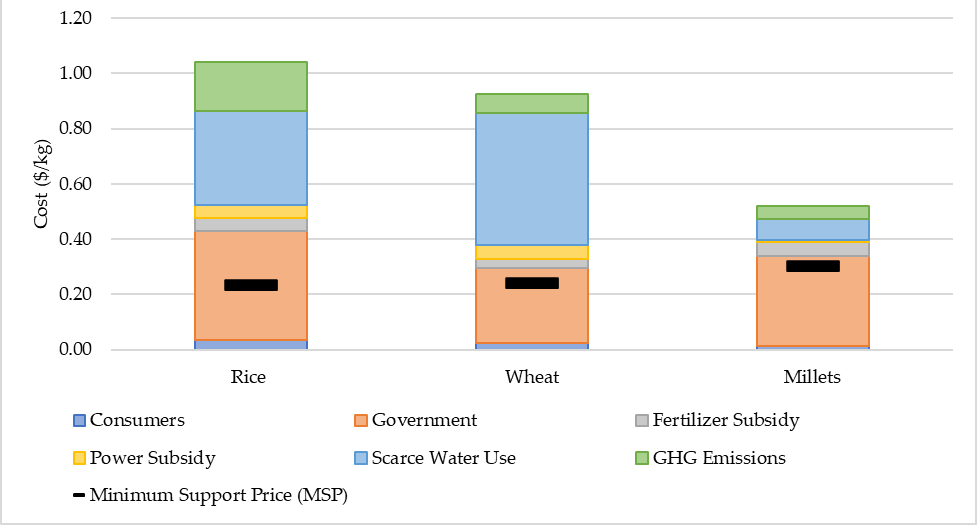
We use per kilogram (rather than per hectare) true costs to account for the differing yields of these food grains. While major millets have a lower carbon and water footprint than rice and wheat, their yields (1,318 kg per hectare) are significantly lower than rice (2,798 kg per hectare) and wheat (3,537 kg per hectare). Despite this difference in yields, major millets have a lower per kilogram true cost than rice and wheat.
The true cost of the PDS can be reduced by either making rice and wheat production more sustainable, or replacing part of these food grains with millets. The former aim can be achieved by adopting more environmentally sustainable production practices that reduce water use and greenhouse gas emissions (such as alternative wetting and drying) or by shifting production from states with declining groundwater levels to states with less water stress. We discuss two of these options—promoting millets in the PDS and shifting food grain procurement from north-western India to eastern India.
Promoting Millets
Although the National Food Security Act, 2013 includes a provision to supply coarse grains through the PDS, major millets accounted for only 1.6% of food grain procurement in 2023-24. Figure 2 shows the trends in food grain production and procurement in India over the past decade. Not only do major millets make up a small share of total procurement, but the proportion of major millets procured (7.6%) is very low compared to rice (42.2%) and wheat (23.1%).
Figure 2: Trends in the Production and Procurement of Food Grain
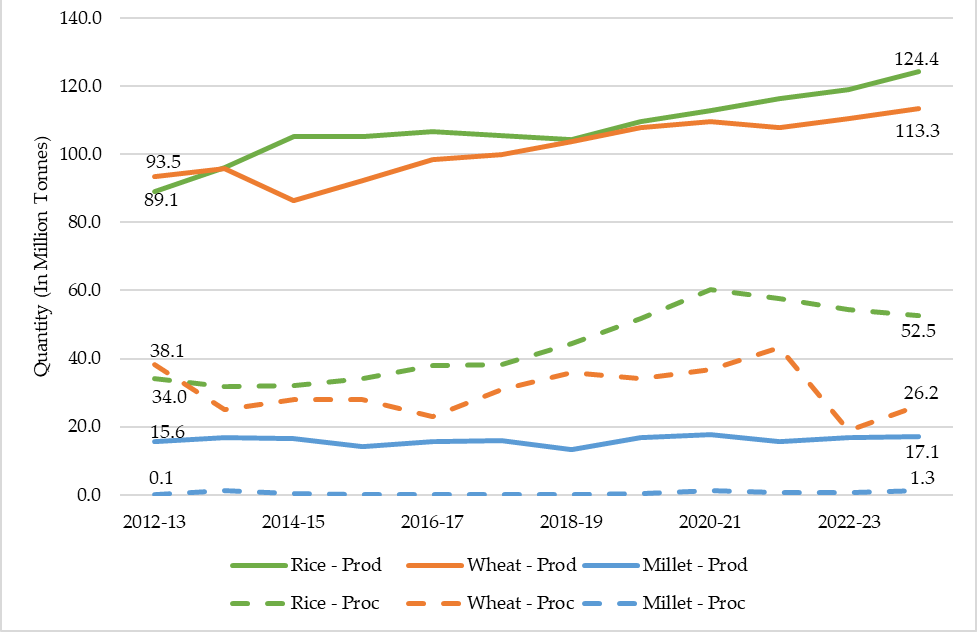
We use our true cost estimates to model a scenario where 1 kg of rice is replaced by 1 kg of major millets for a quarter (~200 million) of PDS beneficiaries every month. Our analysis focuses on replacing just 1 kg of the monthly food grain entitlement for a quarter of PDS beneficiaries because major millet production and procurement are limited, and many people prefer the taste of staple grains. This scenario would require the government to procure 2.6 million tons of major millets, which is twice the amount procured in 2023-24 (or 15% of the total production of major millets).
We find that promoting major millets as a replacement for rice in this scenario results in a 3% reduction in the true cost of the PDS. It also increases incomes for small and marginal farmers in millet-producing states that do not currently benefit from public procurement. This scenario relies on the assumption that a quarter of PDS beneficiaries would replace 1 kg of rice with 1 kg of major millets in their total cereal consumption.
The success of this scenario depends on the government’s capacity to promote the procurement of major millets in millet-producing states such as Karnataka, Rajasthan, Uttar Pradesh, Maharashtra, and Gujarat by supporting the setting up of procurement infrastructure. While the central government has provided guidelines and financial support for supporting the inclusion of coarse grains in the PDS by state governments, this has not resulted in a substantial increase in the procurement of millets.
New data from the household consumption and expenditure survey (HCES) shows that between 2011–12 and 2023–24, households in the poorest consumption quintiles experienced the steepest declines in per capita millet consumption. As shown in Figure 3, millet consumption declined by more than two-thirds among lower quintile households, compared to less than half among those in the upper quintiles.
The relatively higher market prices of millets may help explain the sharper decline in millet consumption among lower income households. Including millets in the PDS could help reverse this trend by improving access and affordability for households in the lower consumption quintiles.
Figure 3: Changes in Per Capita Millet Consumption (by Consumption Levels)
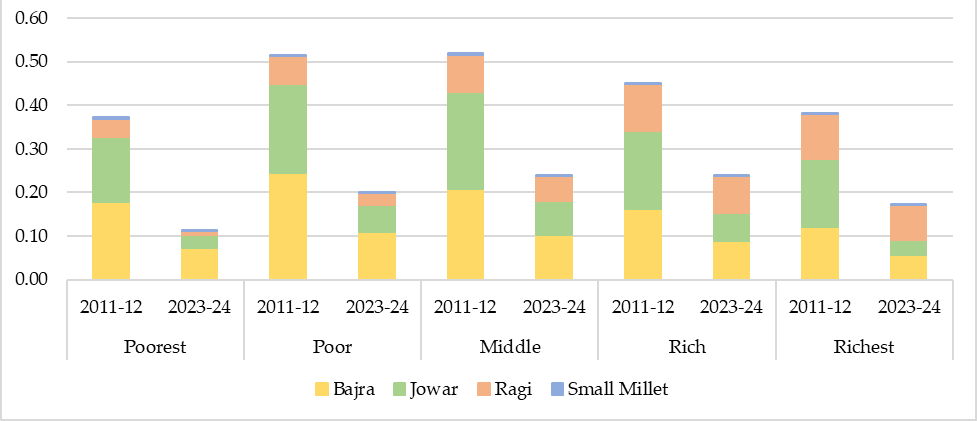
Expanding Procurement
Besides promoting millets in the PDS food basket, a second pathway for making the PDS more sustainable is expanding the procurement of PDS food grain to more states. As most of the food grain for the PDS is procured from a handful of states, many production-related hidden costs are borne by residents of these states.
For example, states such as Punjab and Haryana have experienced a significant decline in their groundwater levels over the past few decades due to the overconsumption of groundwater for agricultural purposes. This decline in groundwater levels has been linked to the incentivisation of rice and wheat cultivation through guaranteed prices for these crops (Chatterjee et al. 2024).
Figure 4 shows the state-wise distribution of the per capita true cost of PDS food grain. Most of these costs are borne by Punjab and Haryana. Despite the existence of the decentralised procurement scheme (DPS) that promotes local procurement of PDS food grain by the states, many rice and wheat producing states do not play a major role in food grain procurement.
Figure 4: State-wise Per Capita True Cost of the PDS (2021-22)
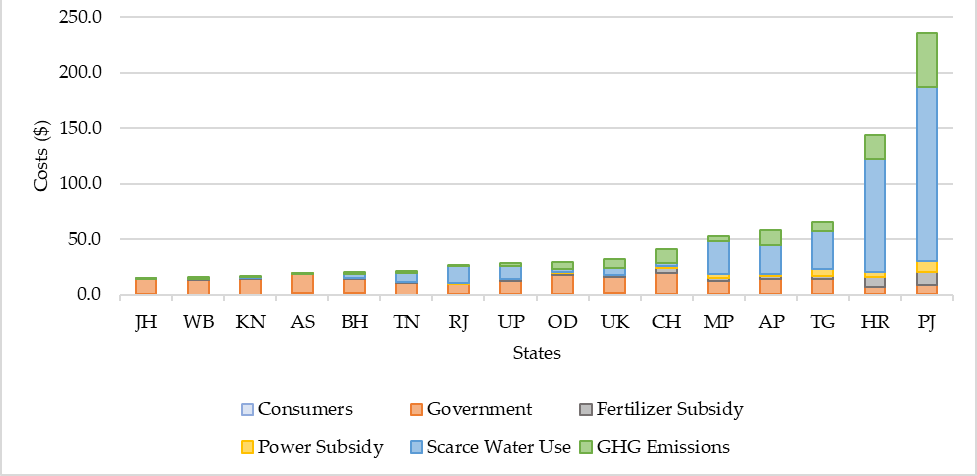
The decentralised procurement scheme was launched in 1997 to promote local (intra-state) procurement of food grain in India. Figure 5 shows the changes in state-wise shares of food grain (rice and wheat) procurement over the past two decades. In 2001-02, 63% of the food grain was procured from Punjab and Haryana. Today, this number has declined to 45% as states such as Chhattisgarh (13%) and Madhya Pradesh (10%) have emerged as major contributors to food grain procurement.
Figure 5: State-wise Procurement of Food Grain (Rice, Wheat, and Major Millets)
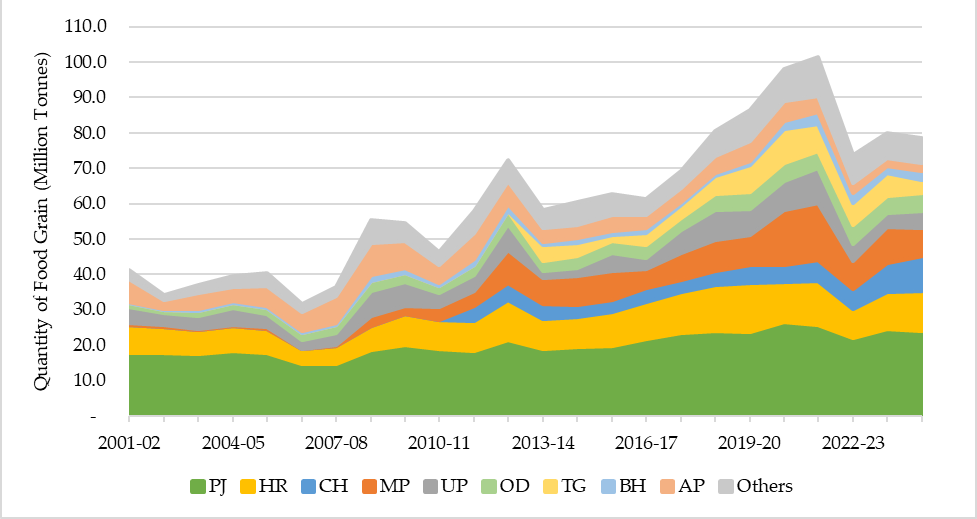
Although there has been a change in the state-wise shares of food grain procurement, many states with large shares of PDS beneficiaries and food grain production do not contribute substantially to food grain procurement. Figure 6 illustrates the state-wise share of rice and wheat procurement in relation to rice and wheat production.
In four states, more than half of the rice and wheat produced is procured. These states include Chhattisgarh (84%), Punjab (76%), Haryana (60%), and Odisha (57%). However, this number is very low for large rice and wheat producers such as Bihar (14%), West Bengal (10%), Uttar Pradesh (7.5%), and Rajasthan (4.2%).
Figure 6: Rice and Wheat Procurement as a Share of Rice and Wheat Production (2023-24)
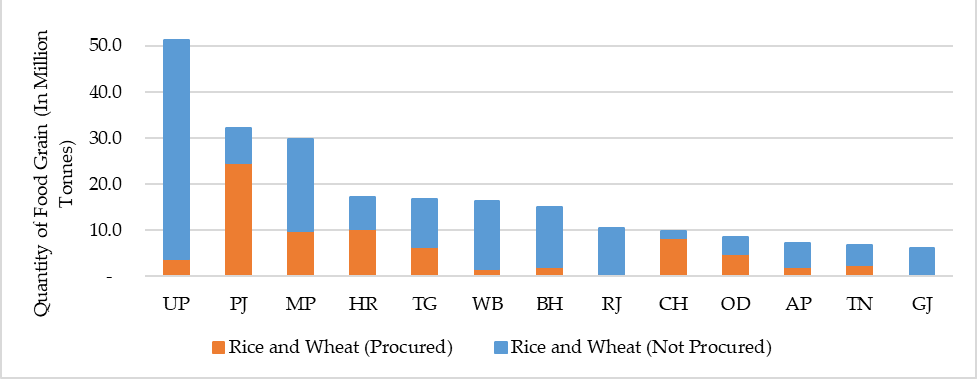
Expanding procurement can help reduce the stress on scarce water resources in north-western India. It can also help expand the benefits of public procurement to more small and marginal farmers across the country, who are now unable to benefit from the minimum support price (MSP) programme.
Concluding Remarks
Public procurement plays a pivotal role in shaping both production and consumption choices within a food system. This is evident in the case of the PDS, where significant procurement of rice and wheat from a handful of states has incentivised the overproduction of these food grains with large water and carbon footprints. This has come at the expense of more sustainable alternatives such as coarse grains, pulses, and oilseeds. The environmental cost is particularly high in states with scarce water resources.
…[P]romoting the distribution of millets through the PDS would necessitate expanding food grain procurement to states such as Rajasthan and Maharashtra, the leading producers of bajra and jowar, respectively.
Reducing the environmental impact of public procurement can help reduce the true cost of the PDS. However, meaningful reform is constrained by the political economy of procurement, especially in the north-western states where farmers are heavily reliant on support prices. Recognising these constraints, we focus on two existing provisions in the National Food Security Act that offer opportunities to reduce the negative environmental impact of the programme without requiring a major overhaul of the system—adding millets to the PDS food basket and further expanding food grain procurement.
Both reforms are already permitted under the National Food Security Act, but their broader adoption will require greater support from the central government. For instance, promoting the distribution of millets through the PDS would necessitate expanding food grain procurement to states such as Rajasthan and Maharashtra, the leading producers of bajra and jowar, respectively.
Other states such as Odisha, which have invested in increasing the production of millets in recent years, can also benefit from additional support to include millets at scale in their PDS. Karnataka provides an example of how millets can be included in the PDS food basket. Over the past decade, Karnataka has accounted for more than half of total procurement and distribution of millets in the PDS at the national level.
Similarly, further expanding of food grain procurement would require the central government to support the creation of procurement infrastructure in states such as Uttar Pradesh and Bihar. Not only will this help reduce the environmental and transportation costs associated with PDS food grain but also allow small and marginal farmers in these states to benefit from the minimum support price scheme.
States such as Chhattisgarh and Odisha provide examples of how decentralisation of food grain procurement can improve farmer livelihoods and provide local food grain to PDS beneficiaries. We should note, however, that Chhattisgarh’s state-level incentives for paddy cultivation (such as a “bonus” support price offered in addition to central support price) have resulted in many farmers in upland areas replacing the cultivation of pulses and millets with paddy (TCI 2025).
Sustainable public procurement can play a significant role in reducing the environmental impact of food systems. True cost accounting can help this endeavour by identifying and quantifying the hidden costs associated with the production, distribution, and consumption of various food items.
Raghav Puri is with the Department of Global Development, Cornell University, Ithaca, New York; Prabhu Pingali is with the Dyson School of Applied Economics and Management, Cornell University, Ithaca, New York.

